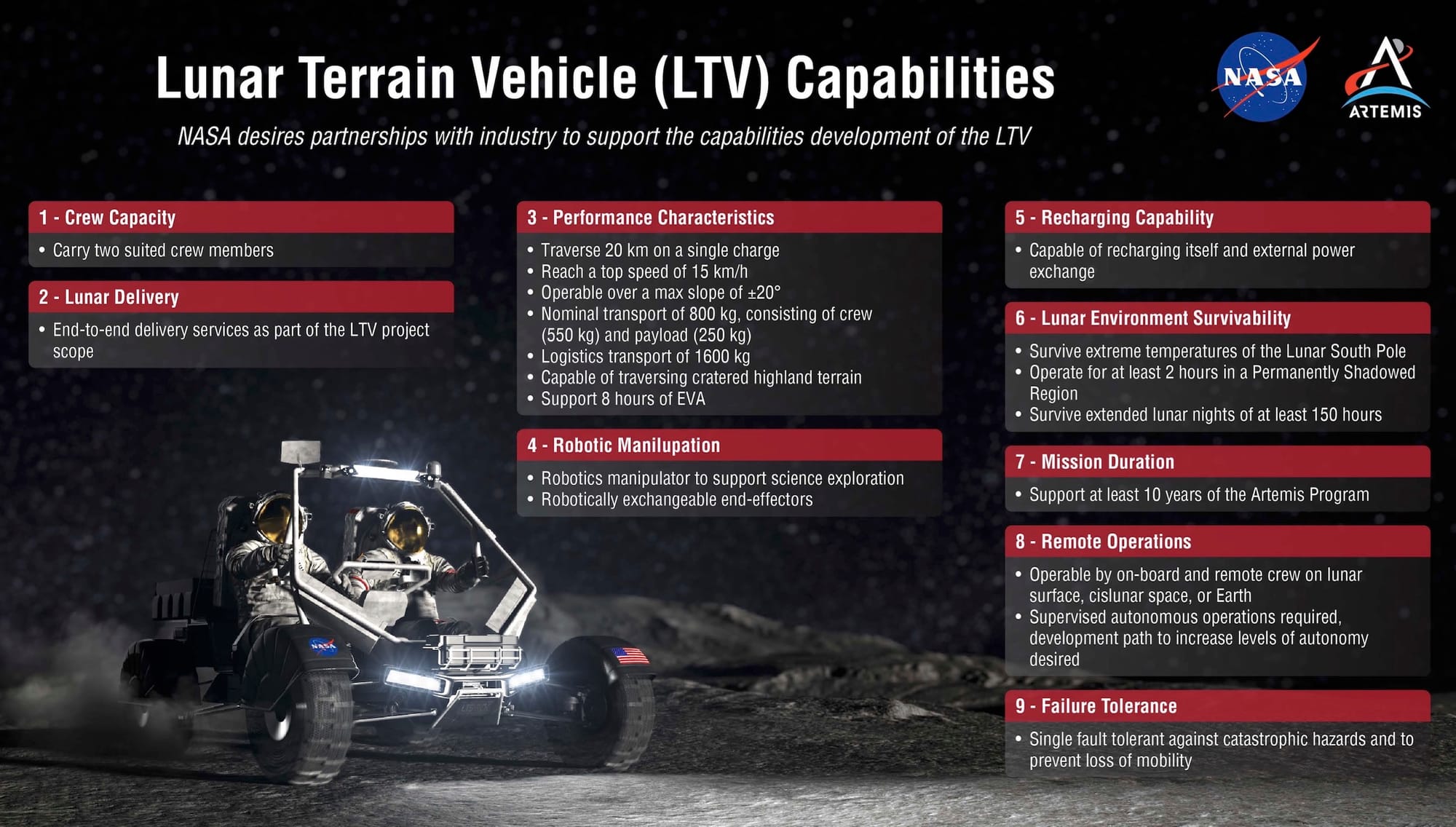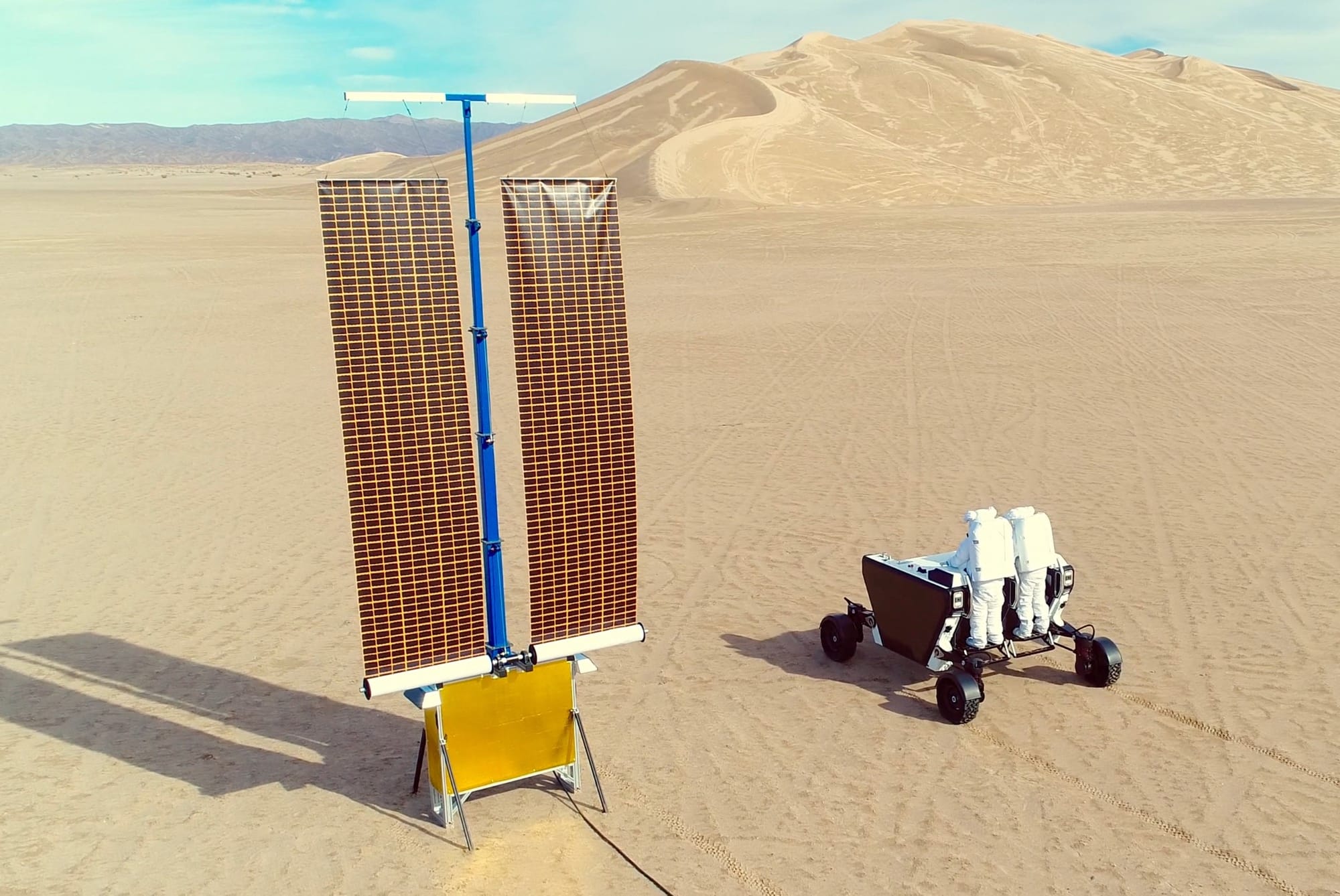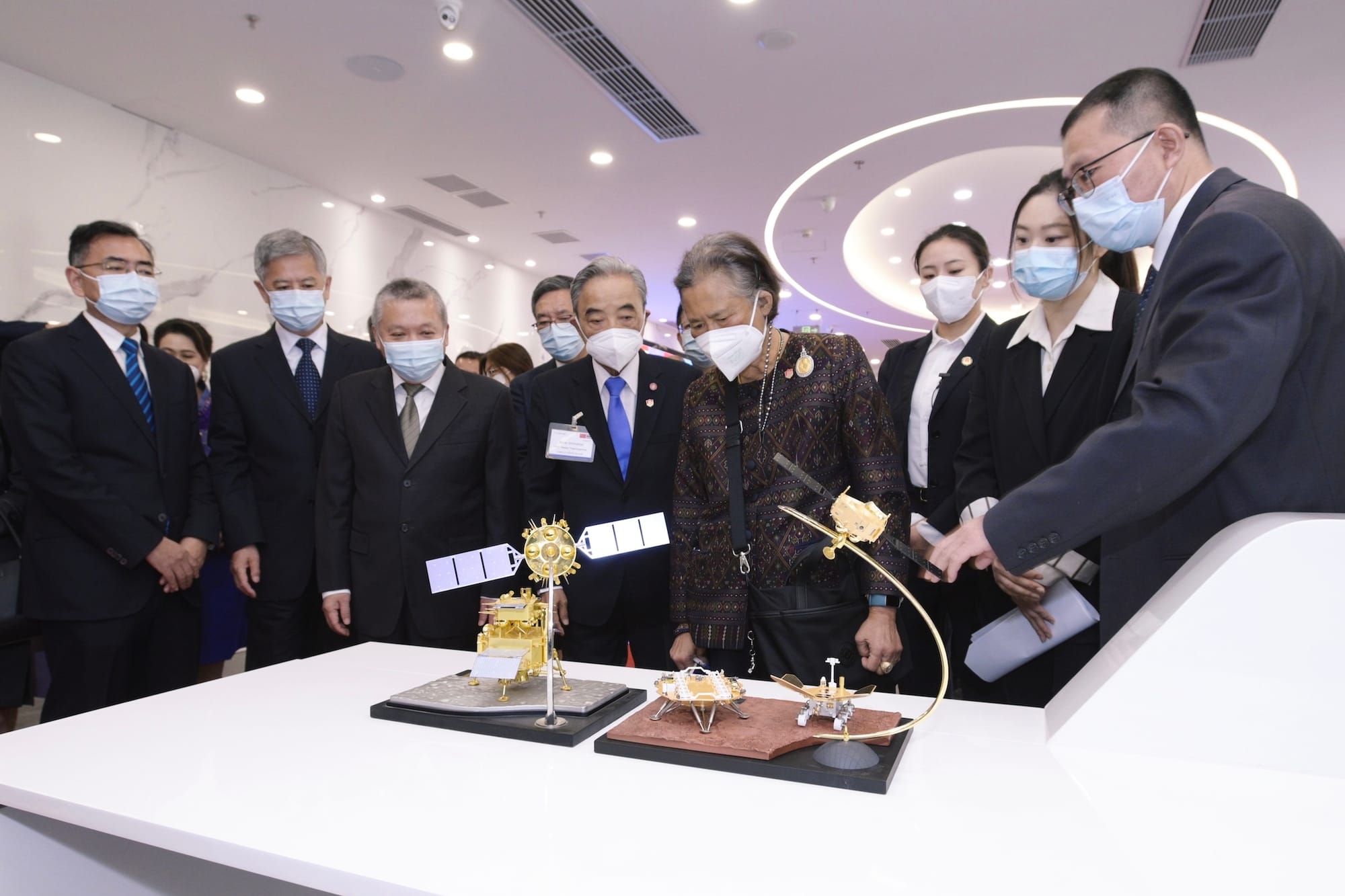Moon Monday #171: One giant leap for rovers, special pages for Artemis & CLPS, and more

On April 3, NASA selected teams led by Intuitive Machines, Lunar Outpost, and Venturi Astrolab to mature their designs for a versatile Lunar Terrain Vehicle (LTV), one of which will be used on a firm, fixed price service basis by NASA across Artemis missions starting with Artemis V end of decade. The service order awards across 10 years have a combined maximum potential value of $4.6 billion. Eric Berger reports that for now NASA is awarding the selected teams a few tens of millions of dollars each to advance their rover designs.
Relatedly, in May 2023, the China Manned Space Agency (CMSA) announced soliciting industry proposals for the country’s first crewed lunar rover, which will be driven by the first two Chinese astronauts on the Moon end of decade.
LTV, a giant leap for rover-kind
Since NASA intends to sustain its return to the Moon, the LTV will be far more capable—as NASA laid out in its solicitation—than the Lunar Roving Vehicle (LRV) driven by Apollo astronauts, and more sophisticated than even the current crop of Mars rovers.
- The LTV will be an unenclosed, all-electric rover that two suited astronauts can drive on the Moon for up to 20 kilometers on an 8-hour roundtrip without having to recharge. That’s roughly thrice Apollo LRV’s range and twice its drive time.
- Unlike Apollo, the LTV will be used across multiple Artemis missions for at least 10 years. This means the LTV must survive frigid night-time temperatures on the Moon’s south pole every month, which can last from several hours up to at least 150 hours even in favorably selected high-altitude locations. That’s even better than NASA’s upcoming water-ice studying VIPER rover, which is being designed to survive complete darkness periods of about 96 hours by parking at pre-identified high-altitude spots during its mission.
- The LTV should be able to traverse 20-degree slopes, and in general navigate the challenging rugged terrain at the Moon’s south pole. Within this slope limit, the LTV should be able to spend up to two hours in permanently shadowed regions, where temperatures drop well below -180 degrees Celsius. Combined with the same requirement for Artemis spacesuits, this sets the stage for astronauts exploring and bringing cryogenic samples of pristine, precious lunar volatiles to Earth for meticulous lab studies, an identified key priority for Artemis science. To that end, NASA would also like the LTV to have a robotic manipulator arm for deploying science instruments and more. Exciting stuff!
- Given LTV’s criticality to astronauts being able to safely return to the lander or a future Artemis Base Camp after or during traverses, the rover’s mobility must be at least single-fault tolerant.
- NASA wants the LTV to be remotely operable from Earth, and that it should have sufficient autonomous capabilities. These requirements chiefly come from NASA’s Science Mission Directorate to ensure efficient scientific use of the rover when a crewed mission isn’t ongoing, which will be at least 11 months a year per current planning of Artemis missions.
- In addition to a carrying a suited crew of two weighing about 550 kilograms, the LTV must transport up to 250 kilograms of cargo, science instruments, lunar samples, and technology demonstration payloads between desired points on the Moon. For non-crew traverses, the LTV should be able to carry 1600 kilograms at reduced speeds.

Unlike concepts by Intuitive Machines (via Northrop Grumman) and Lunar Outpost (which switched sides from Northrop to Lockheed Martin for the LTV bid), only the Astrolab-led FLEX has a fully-functional terrestrial prototype as far as we know, and which has been tested for mobility, crewed, and remote operations, including test deployments of a variety of large payloads. Astrolab is also the only company to have publicly announced a plan to send a demonstration rover much before Artemis V, with one FLEX heading to the Moon on a 2026 Starship launch carrying at least eight customer payloads worth $160 million.
It should be noted that the LTV is just one of the two rover types part of NASA’s Artemis Base Camp, which aims to build the infrastructure necessary for at least a few astronauts to live long-term on the Moon. The other rover is a pressurized, habitable one, which would enable astronauts to explore the Moon’s south pole for up to 42 days at a time. NASA is expected to but hasn’t yet formally confirmed including the upcoming JAXA-Toyota autonomous crewed pressurized rover to said end. JAXA hopes to land a Japanese on the Moon via an Artemis mission in return for providing this advanced crewed pressurized rover.
Relatedly, recall that last year Canada said it will invest $1.2 billion over 13 years to develop a “Lunar Utility Vehicle”, which aims to provide critical assistance to Artemis astronauts on future missions. Canada hopes that just like how contributing their Canadarm3 robotics servicing system to the upcoming NASA-led Gateway lunar orbital habitat bagged seats for their astronauts on circumlunar Artemis missions, such a rover will enable a Canadian to walk on the Moon.
Many thanks to Epsilon3 and Off Planet Research for sponsoring this week’s Moon Monday. If you love this community resource too, join them!
Renamed Gateway elements and redesigned RS-25s
The HALO habitat module, part of the NASA-led Gateway, is set to undergo a series of tests ahead of final outfitting and preparations for a late 2025 launch on a SpaceX Falcon Heavy rocket. HALO will be docked to the PPE propulsion module before launch. In the meanwhile, ESA decided to rename their Gateway contributions, the modules of which will be added to the HALO-PPE Gateway later this decade. The Gateway’s i-HAB habitation module is now called the Lunar I-Hab, the ESPRIT communications module the Lunar Link, and the ERM Gateway refueling and cargo module the Lunar View—owing to its windows which will surely provide breathtaking views of space, our Moon, and Earth to astronauts.
Also see: A gist of Gateway science

On April 3, NASA completed a second and final campaign of 12 hot fire tests of the redesigned RS-25 engine. This means contractor Aerojet Rocketdyne can now produce such RS-25s for NASA to power future SLS rocket flights starting with Artemis V end of decade. The agency has awarded the company contracts to provide 24 new engines, supporting SLS launches up to Artemis IX.
The hot fire tests included eight 500-second firings—the same amount of time as required during an SLS mission—and four longer burns for ensuring margins. Engineers and operators also test flight-like gimbaling of the engine, which during a mission helps stabilize the rocket as well as keep it on its intended trajectory. Like the engine used in the first test campaign, the second one also features new components like a nozzle, hydraulic actuators, flex ducts, and turbo pumps. The aim with the second set of hot fires though was to test production reliability by validating the performance of a second set of hardware.
NASA says the new RS-25 engines should cost over 30% less to produce, from the current $100 million+, but a scathing May 2023 report from NASA’s Office of Inspector General pointed out that this projected figure excludes project management and overhead costs.
Thailand and China collaborate on lunar exploration

On April 5, Thailand joined the upcoming China-led long-term scientific base on the Moon’s south pole called the International Lunar Research Station (ILRS), becoming the ninth country to do so. This move comes after Thailand’s largest space research organization, the National Astronomical Research Institute of Thailand (NARIT), joined the ILRS project in September 2023.
As Ling Xin reported previously, NARIT has a 3-kilogram instrument duo onboard China’s upcoming Chang’e 7 orbiter to study solar storms and cosmic rays respectively. China is aiming to launch the orbiter in 2026 alongside the namesake lander. NARIT also operates the Thai National Radio Telescope, which could be used to monitor spacecraft trajectories of ILRS missions in the future.
More Moon
- The US White House has asked NASA to develop a strategy by the end of 2026 for creating an independent time standard for the Moon, a Coordinated Lunar Time (LTC) that ties back in to Earth’s UTC. Rather than the White House’s policy document though, it’s Elizabeth Gibney’s article from last year which better explains why an independent lunar time is desirable, how ESA and NASA have already been working towards the same, and how it would enable swarms of spacecraft to better operate at Luna.
- Alan Stern has joined ispace US as a scientific advisor. His scientific accomplishments in space exploration are well recognized but less known is that he was also the principal investigator of the LAMP instrument aboard NASA’s Lunar Reconnaissance Orbiter. LAMP has helped indicate potential water ice deposits within lunar polar permanently shadowed regions.
- You can now browse my ongoing contextual coverage of NASA’s Artemis and CLPS programs via dedicated pages for those topics on my blog:
